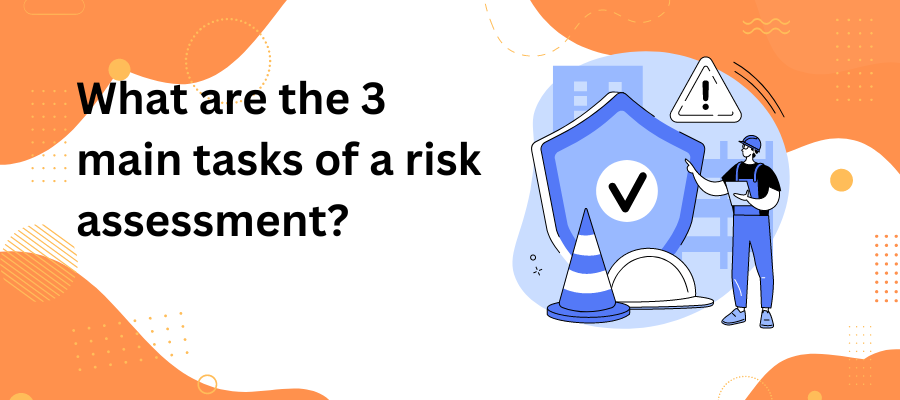In any company or industry, the safety and well-being of employees and the public are of utmost importance. That’s why risk assessments play a critical role in identifying potential hazards and implementing appropriate precautions to minimize risks.
In this article, we will explore the three main tasks of a risk assessment: understanding risk assessment, identifying hazards, and evaluating risks.
Understanding Risk Assessment
Before delving into the tasks involved in a risk assessment, it is crucial to have a clear understanding of what risk assessment entails and why it is important.
Risk assessment is not just a mere checklist or a box-ticking exercise. It is a systematic and comprehensive process that plays a critical role in ensuring the safety and well-being of individuals and the environment. By identifying, evaluating, and controlling potential hazards, risk assessment aims to prevent accidents, injuries, or harm.
At its core, risk assessment is about understanding the risks involved in any given situation and taking appropriate measures to mitigate those risks. It is a proactive approach that allows organizations to anticipate and address potential hazards before they have a chance to cause harm.
There are several key steps involved in the risk assessment process:
- Identification of Hazards: The first step in risk assessment is to identify all potential hazards that could pose a risk to individuals or the environment. This can include physical hazards, such as machinery or chemicals, as well as non-physical hazards, such as ergonomic or psychological factors.
- Evaluation of Risks: Once the hazards have been identified, the next step is to evaluate the risks associated with each hazard. This involves assessing the likelihood of an incident occurring and the potential consequences if it does.
- Control Measures: Based on the evaluation of risks, control measures are then implemented to reduce or eliminate the risks identified. This can include engineering controls, administrative controls, or personal protective equipment.
- Monitoring and Review: Risk assessment is an ongoing process, and it is essential to regularly monitor and review the effectiveness of the control measures in place. This allows organizations to identify any changes in the risks or the introduction of new hazards.
The First Task: Identifying the Hazards
The initial step in a risk assessment is identifying potential hazards that may pose a risk to individuals, property, or the environment.
What is a Hazard in Risk Assessment?
A hazard, in the context of risk assessment, refers to any potential source of harm or danger that could lead to an accident, injury, or damage. This could include physical hazards, such as machinery or chemicals, as well as non-physical hazards like ergonomic or psychosocial factors.
Techniques for Identifying Hazards
There are various techniques used to identify hazards during a risk assessment. These can include observations, inspections, interviews with employees, reviewing incident records, and analyzing data related to accidents or near misses. This comprehensive approach ensures that all potential hazards are identified and assessed.
The Second Task: Determining Who Might be Harmed and How
Once the hazards have been identified, the next step is to determine who might be affected by these hazards and in what ways.
Identifying Potential Victims
During this task, it is crucial to identify all individuals who may be at risk as a result of the identified hazards. This includes employees, visitors, contractors, or anyone who may come into contact with the hazard. Understanding who might be harmed allows for targeted risk management strategies to be implemented.
Predicting Possible Harm
After identifying potential victims, it is important to assess the potential harm that could occur if the hazards are not properly controlled. This could range from minor injuries to life-threatening situations. By understanding the potential harm, appropriate preventive measures can be put in place.
The Third Task: Evaluating Risks and Deciding on Precautions
With a clear understanding of the hazards and potential harm, the next task in a risk assessment is to evaluate the risks associated with each hazard and decide on appropriate precautions.
Risk Evaluation Techniques
Risk evaluation involves assessing the likelihood and severity of the identified risks. Techniques such as risk matrix, risk rating, or risk scoring are commonly used to prioritize risks based on their potential impact. This evaluation provides valuable insights for determining the necessary precautions.
Choosing Appropriate Precautions
Based on the evaluation of risks, suitable precautions can be selected to control and minimize the identified hazards. These precautions can include engineering controls, administrative measures, personal protective equipment (PPE), or a combination of these. The aim is to reduce the risks to an acceptable level.
Implementing the Risk Assessment
Once the risk assessment has been conducted and appropriate precautions have been determined, the next step is to implement the risk assessment findings.
How to Apply Risk Assessment Findings
Implementing the risk assessment involves putting in place the recommended control measures and ensuring that they are followed consistently. This may include updating policies and procedures, providing training and awareness programs, or modifying equipment or work processes to reduce risks. Regular communication and monitoring are key components of successful implementation.
Monitoring and Reviewing the Risk Assessment
Risk assessments should not be considered a one-time activity. Periodic monitoring and reviewing of the risk assessment are essential to ensure that the control measures remain effective and up-to-date. As organizations evolve and new hazards emerge, the risk assessment must be revised accordingly to maintain a safe working environment.
In conclusion, understanding the three main tasks of a risk assessment – understanding risk assessment, identifying hazards, and evaluating risks – is crucial for organizations to ensure the safety and well-being of everyone involved. By following this systematic process, potential hazards can be identified, appropriate precautions can be implemented, and risks can be effectively managed. With a commitment to ongoing monitoring and review, organizations can continuously improve their risk assessment practices and maintain a safe environment for all.
More from the EHS Blog
The Rail Forum AGM and Networking Event was an incredible...
When you think of Top Gun, images of high-speed jets,...
When it comes to animated series, few characters are as...
When we think of Wolverine, the iconic Marvel character, several...



